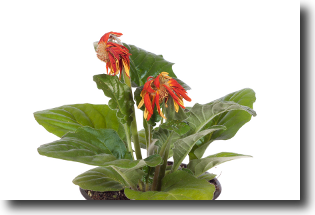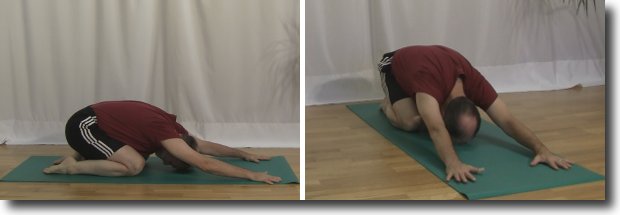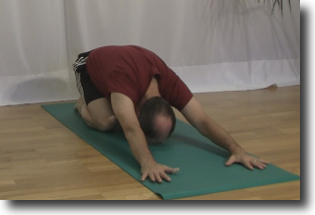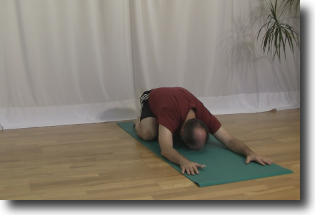Alice is feeling as wilted as the flowers she saw in a store window on the way to yoga class. She is doing a vigorous yoga practice and has run out of energy. But Alice has a plan to bring fresh energy to her practice. She is taking a break in Balasana.
What is Balasana
Balasana which is pronounced bah-LAHS-Anna is Sanskrit for Child’s pose. This pose is a deep forward bend that is often used as a resting or rejuvenating pose.
What are the benefits of Balasana
Balasana is an excellent pose to rejuvenate your body and help you to recover your energy. You reduce the demand on your heart and lungs when move into Balasana with your head resting on the floor and your knees tucked into your chest. This reduced demand on your heart and lungs allows your body to quickly recover its energy.
Balasana also gently stretches your lower back, hips, thighs, knees, and ankles. It relaxes your spine, shoulders, and neck.
The blood circulation to your head increases when you are in Balasana which reduces headaches. The pose calms your mind, relieving stress and tension while it massages your internal organs.
How to do Balasana
You can enter Balasana from three different positions: Standing; Downward Facing Dog; or Seated.
From Standing
You start standing tall in Tadasana and then you move into Table pose.
From standing you bring your knees to the floor and your hands to the floor beyond your knees. Your wrists are directly beneath your shoulders and your fingers are spread and pointing forward. Your hips are over your knees and there is a gap between your knees and between your feet. Your back is straight and parallel to the floor. This is Table pose.
From Downward Facing Dog
Balasana is often used as a resting pose when you are doing a series of Sun Salutes. When you reach Downward Facing Dog you can take a rest break by entering Balasana.
Drop your knees to the floor and move your torso forward slightly so that your hips are above your knees and your shoulders are above your hands. There is no need to move your hands or feet. They are already in the correct position.
From Seated
You start out sitting tall in Dandasana with your arms by your sides, your torso tall and your legs together straight out in front of you.
Move forward and come to your hands and knees in Table pose similar to moving from standing described above.
Regardless of how you got to Table pose it is time to move on to Balasana.
Move Into Balasana
Exhale and drop your knees to the floor and flatten your feet to the floor by pointing your toes away from your knees. Lower your hips towards your heels and your torso towards your knees.
Bring your head to the floor between your arms.
Stay here for several breaths or until your energy returns and you are ready to carry on with your yoga practice.
Back to Standing
To return to standing, move to table by lifting your head from the floor, your torso from your thighs and bring your hips up above your knees once again. From here bring your hands back towards your feet, lift your knees from the floor and come to standing.
Back to Downward Facing Dog
To return to Downward Facing Dog, lift your head up off of the floor, lift your torso off of your legs and while lifting your hips away from your heels straighten your legs. Your hands and feet do not move when you entered Balasana. When you finish straightening your legs you will be once again in Downward Facing Dog.
Back to Seated
To leave Child’s pose and return to seated, return to table position as described above and then lower your hips to the floor as you bring your legs forward in front of you.
When to do Balasana
There are many times that you or your teacher can take advantage of the restorative nature of Child’s pose.
- Lack of energy
- Negative thoughts
- A pause in the flow
Lack of energy
Alice is feeling like that wilted flower she saw. Balasana is the right pose for Alice to do at this time to help her rest and rebuild her energy reserves. Once her energy has returned she will be ready to rejoin the yoga practice.
Negative thoughts
You may wish that the teacher would pause in the practice so you can rest and get your energy back. But the teacher keeps going on to the next pose and then the one after that. There is no break in sight. Rather than thinking negative thoughts about your teacher, the style of yoga or yoga in general, take a break and move into Balasana. Once your mind has settled down and your negative thoughts have left rejoin the practice feeling refreshed and renewed.
A pause in the flow
Your teacher may incorporate Child’s pose into the class plan. There are places in a yoga practice where a restorative break will be very useful and appreciated by everyone.
But my belly gets in the way
If you have an extra large belly, you may not be able to comfortably lower your torso onto your thighs.
To accommodate your extra large belly spread you knees away from each other towards the edge of the mat. This will create a space that your torso can lower down into. You will be able to rest the sides of your torso on your thighs and bring your head to the floor.
But my hips do not come to my heels
Tight quadriceps or inflexible hips will prevent you from bringing your hips to your heels.
To make Balasana a comfortable pose and to support your hips you can place a foam, a folded up blanket, or a bolster between your heels and your hips to provide support to your hips and take the pressure off of your quadriceps.
Once you provide support for your hips Balasana will become a comfortable pose.
But the top of my feet hurt
When you attempt to put your feet flat to the floor you may discover that your ankles are not flexible enough. Your ankles will be stuck up in the air and the pressure of bringing your hips to your heels will make the top of your feet very uncomfortable.
You can take two actions here to remove this pressure and discomfort.
- You can put a small support such as a rolled up towel between the ankle and the floor, if there is only a small gap between the ankles and the floor.
- Rather than putting your feet flat to the floor, tuck your toes under and lift your heels up. This will remove all the pressure from your ankles.
But my head does not reach the floor
If you are unable to get your head to the floor when your lower your torso there are two things that you can do.
- If your head is almost to the floor you can make a fist with your hand and place it between your head and the floor.
- If your head does not reach your fist then it is time to use a prop. Place a block or foam between your head and the floor to provide the support that you need.
Summary
Alice no longer feels like that wilted flower she saw in the window. She used Balasana to help her recover her energy. Now she is ready to resume her yoga practice.
Balasana is a restorative yoga pose that you can use when:
- your energy levels are low
- you are having negative thoughts
- you need a pause in your yoga practice.
In addition to helping your restore your energy levels, Balasana also stretches your back and can help make a headache go away.
Next Step
If you are having challenges with Balasana ask your yoga teacher to suggest some modifications that will help you to enjoy this pose.
Additional Reading
A 108 Sun Salute Challenge can be quite demanding. Learn how to incorporate Balasana into this challenge by reading How Child’s pose improves your 108 Sun Salute Challenge experience.
Incorporating Balasana into your yoga practice teaches you to respect your limits and not injury yourself. To find out more about avoiding injury during your yoga practice read the article Goldilocks and the 3 bears find the edge.








